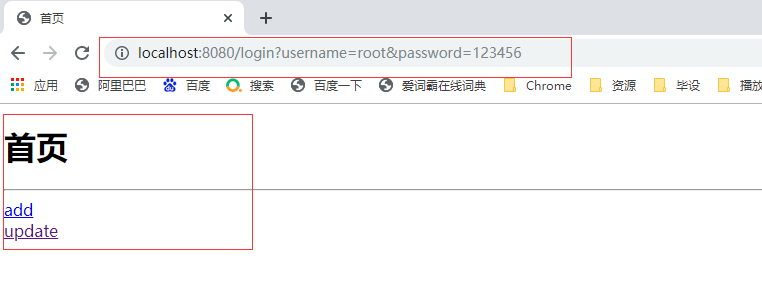1、Durid 1.1 簡介 Java程式很大一部分要操作資料庫,為了提高性能操作資料庫的時候,又不得不使用資料庫連接池。 Druid 是阿裡巴巴開源平臺上一個資料庫連接池實現,結合了 C3P0、DBCP 等 DB 池的優點,同時加入了日誌監控。 Druid 可以很好的監控 DB 池連接和 SQL ...
1、Durid
1.1 簡介
Java程式很大一部分要操作資料庫,為了提高性能操作資料庫的時候,又不得不使用資料庫連接池。
Druid 是阿裡巴巴開源平臺上一個資料庫連接池實現,結合了 C3P0、DBCP 等 DB 池的優點,同時加入了日誌監控。
Druid 可以很好的監控 DB 池連接和 SQL 的執行情況,天生就是針對監控而生的 DB 連接池。
Druid已經在阿裡巴巴部署了超過600個應用,經過一年多生產環境大規模部署的嚴苛考驗。
Spring Boot 2.0 以上預設使用 Hikari 數據源,可以說 Hikari 與 Driud 都是當前 Java Web 上最優秀的數據源,我們來重點介紹 Spring Boot 如何集成 Druid 數據源,如何實現資料庫監控。
Github地址:https://github.com/alibaba/druid/

1.2 依賴
<!-- druid begin -->
<dependency>
<groupId>com.alibaba</groupId>
<artifactId>druid</artifactId>
<version>1.2.8</version>
</dependency>
<!-- druid end -->
<!-- log4j begin -->
<dependency>
<groupId>log4j</groupId>
<artifactId>log4j</artifactId>
<version>1.2.17</version>
</dependency>
<!-- log4j begin -->
1.3 配置
1.3.1 application.yml
# 埠
server:
port: 9603
# 服務名
spring:
application:
name: kgcmall96-user
# 數據源配置
datasource:
driver-class-name: com.mysql.cj.jdbc.Driver
url: jdbc:mysql://localhost:3306/kh96_alibaba_kgcmalldb?useUnicode=true&characterEncoding=utf-8&useSSL=false&serverTimezone=GMT
username: root
password: root
#2、切換數據源;之前已經說過 Spring Boot 2.0 以上預設使用 com.zaxxer.hikari.HikariDataSource 數據源,但可以 通過 spring.datasource.type 指定數據源。
# 指定數據源類型
type: com.alibaba.druid.pool.DruidDataSource
# 數據源其他配置
# 初始化時建立物理連接的個數。初始化發生在顯示調用init方法,或者第一次getConnection時
initialSize: 5
# 最小連接池數量
minIdle: 5
# 最大連接池數量
maxActive: 20
# 獲取連接時最大等待時間,單位毫秒。
maxWait: 60000
# 配置間隔多久才進行一次檢測,檢測需要關閉的空閑連接,單位是毫秒
timeBetweenEvictionRunsMillis: 60000
# 配置一個連接在池中最小生存的時間,單位是毫秒
minEvictableIdleTimeMillis: 300000
# 用來檢測連接是否有效的sql,要求是一個查詢語句。如果validationQuery為null,testOnBorrow、testOnReturn、testWhileIdle都不會其作用。
validationQuery: SELECT 1 FROM DUAL
# 建議配置為true,不影響性能,並且保證安全性。申請連接的時候檢測,如果空閑時間大於timeBetweenEvictionRunsMillis,執行validationQuery檢測連接是否有效
testWhileIdle: true
# 申請連接時執行validationQuery檢測連接是否有效,做了這個配置會降低性能。
testOnBorrow: false
# 歸還連接時執行validationQuery檢測連接是否有效,做了這個配置會降低性能
testOnReturn: false
# 是否緩存preparedStatement,也就是PSCache。PSCache對支持游標的資料庫性能提升巨大,比如說oracle。在mysql下建議關閉
poolPreparedStatements: false
maxPoolPreparedStatementPerConnectionSize: 20
# 合併多個DruidDataSource的監控數據
useGlobalDataSourceStat: true
# 配置監控統計攔截的filters,去掉後監控界面sql無法統計
# 屬性性類型是字元串,通過別名的方式配置擴展插件,常用的插件有:監控統計用的filter:stat日誌用的filter:log4j防禦sql註入的filter:wall
filters: stat,wall,log4j
# 通過connectProperties屬性來打開mergeSql功能;慢SQL記錄
connectionProperties: druid.stat.mergeSql=true;druid.stat.slowSqlMillis=500
# jpa配置
jpa:
hibernate:
ddl-auto: update
show-sql: true
1.3.2 log4j.properties
在網上隨便搜的一個;
log4j.rootLogger=DEBUG, stdout
# Console output...
log4j.appender.stdout=org.apache.log4j.ConsoleAppender
log4j.appender.stdout.layout=org.apache.log4j.PatternLayout
log4j.appender.stdout.layout.ConversionPattern=%5p [%t] - %m%n
1.4 Druid數據源配置類
/**
* @author : huayu
* @date : 29/11/2022
* @param :
* @return :
* @description : Druid數據源配置類
*/
@Configuration
public class DruidConfig {
@Bean
@ConfigurationProperties(prefix = "spring.datasource")
public DataSource dataSource() {
return new DruidDataSource();
}
/**
* 配置後臺管理
*/
@Bean
public ServletRegistrationBean statViewServlet() {
ServletRegistrationBean bean = new ServletRegistrationBean(new StatViewServlet(), "/druid/*");
// 初始化參數
Map<String, String> initParams = new HashMap<>();
initParams.put("loginUsername", "admin");
initParams.put("loginPassword", "123456");
// 是否允許訪問
initParams.put("allow", "");
bean.setInitParameters(initParams);
return bean;
}
/**
* 配置web監控的過濾器
*/
@Bean
public FilterRegistrationBean webStatFilter() {
FilterRegistrationBean bean = new FilterRegistrationBean();
bean.setFilter(new WebStatFilter());
// 初始化參數
Map<String, String> initParams = new HashMap<>();
// 排除過濾,靜態文件等
initParams.put("exclusions", "*.css,*.js,/druid/*");
bean.setInitParameters(initParams);
bean.setUrlPatterns(Arrays.asList("/*"));
return bean;
}
}
1.5 測試
測試代碼不在贅述,就簡單寫一個測試請求就好;
1.5.1 登錄

1.5.2 測試請求

2、SpringSecurity
2.0 認識SpringSecurity
Spring Security 是針對Spring項目的安全框架,也是Spring Boot底層安全模塊預設的技術選型,他可以實現強大的Web安全控制,對於安全控制,我們僅需要引入 spring-boot-starter-security 模塊,進行少量的配置,即可實現強大的安全管理!
記住幾個類:
- WebSecurityConfigurerAdapter:自定義Security策略
- AuthenticationManagerBuilder:自定義認證策略
- @EnableWebSecurity:開啟WebSecurity模式
Spring Security的兩個主要目標是 “認證” 和 “授權”(訪問控制)。
“認證”(Authentication)
身份驗證是關於驗證您的憑據,如用戶名/用戶ID和密碼,以驗證您的身份。
身份驗證通常通過用戶名和密碼完成,有時與身份驗證因素結合使用。
“授權” (Authorization)
授權發生在系統成功驗證您的身份後,最終會授予您訪問資源(如信息,文件,資料庫,資金,位置,幾乎任何內容)的完全許可權。
這個概念是通用的,而不是只在Spring Security 中存在。
2.1 項目介紹
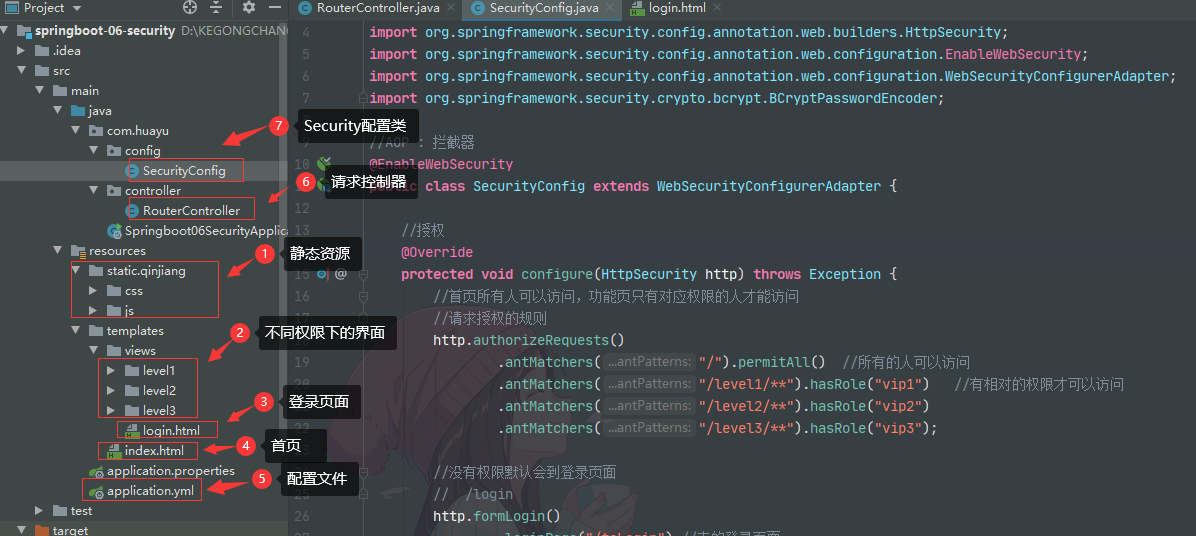
2.1 依賴
<!-- thymeleaf -->
<dependency>
<groupId>org.springframework.boot</groupId>
<artifactId>spring-boot-starter-thymeleaf</artifactId>
</dependency>
<!-- security -->
<dependency>
<groupId>org.springframework.boot</groupId>
<artifactId>spring-boot-starter-security</artifactId>
</dependency>
<!-- security-thymeleaf整合包 -->
<dependency>
<groupId>org.thymeleaf.extras</groupId>
<artifactId>thymeleaf-extras-springsecurity5</artifactId>
<version>3.0.4.RELEASE</version>
</dependency>
2.2 application.yml
# 關閉模板緩存
spring:
thymeleaf:
cache: false
2.3 html
2.3.1 1.html
創建這幾個文件;

1.html(這幾個html的代碼都是一樣的)
<!DOCTYPE html>
<html lang="en" xmlns:th="http://www.thymeleaf.org">
<head>
<meta charset="UTF-8">
<meta name="viewport" content="width=device-width, initial-scale=1, maximum-scale=1">
<title>首頁</title>
<!--semantic-ui-->
<link href="https://cdn.bootcss.com/semantic-ui/2.4.1/semantic.min.css" rel="stylesheet">
<link th:href="@{/qinjiang/css/qinstyle.css}" rel="stylesheet">
</head>
<body>
<!--主容器-->
<div class="ui container">
<div th:replace="~{index::nav-menu}"></div>
<div class="ui segment" style="text-align: center">
<h3>Level-1-1</h3>
</div>
</div>
<script th:src="@{/qinjiang/js/jquery-3.1.1.min.js}"></script>
<script th:src="@{/qinjiang/js/semantic.min.js}"></script>
</body>
</html>
2.3.2 login.html
<!DOCTYPE html>
<html lang="en" xmlns:th="http://www.thymeleaf.org">
<head>
<meta charset="UTF-8">
<meta name="viewport" content="width=device-width, initial-scale=1, maximum-scale=1">
<title>登錄</title>
<!--semantic-ui-->
<link href="https://cdn.bootcss.com/semantic-ui/2.4.1/semantic.min.css" rel="stylesheet">
</head>
<body>
<!--主容器-->
<div class="ui container">
<div class="ui segment">
<div style="text-align: center">
<h1 class="header">登錄</h1>
</div>
<div class="ui placeholder segment">
<div class="ui column very relaxed stackable grid">
<div class="column">
<div class="ui form">
<form th:action="@{/login}" method="post">
<div class="field">
<label>Username</label>
<div class="ui left icon input">
<input type="text" placeholder="Username" name="username">
<i class="user icon"></i>
</div>
</div>
<div class="field">
<label>Password</label>
<div class="ui left icon input">
<input type="password" name="password">
<i class="lock icon"></i>
</div>
</div>
<div class="field">
<input type="checkbox" name="remember"> 記住我
</div>
<input type="submit" class="ui blue submit button"/>
</form>
</div>
</div>
</div>
</div>
<div style="text-align: center">
<div class="ui label">
</i>註冊
</div>
<br><br>
<small>blog.kuangstudy.com</small>
</div>
<div class="ui segment" style="text-align: center">
<h3>Spring Security Study by 秦疆</h3>
</div>
</div>
</div>
<script th:src="@{/qinjiang/js/jquery-3.1.1.min.js}"></script>
<script th:src="@{/qinjiang/js/semantic.min.js}"></script>
</body>
</html>
2.3.3 index.html
<!DOCTYPE html>
<html lang="en" xmlns:th="http://www.thymeleaf.org"
xmlns:sec="http://www.thymeleaf.org/thymeleaf-extras-springsecurity5">
<head>
<meta charset="UTF-8">
<meta name="viewport" content="width=device-width, initial-scale=1, maximum-scale=1">
<title>首頁</title>
<!--semantic-ui-->
<link href="https://cdn.bootcss.com/semantic-ui/2.4.1/semantic.min.css" rel="stylesheet">
<link th:href="@{/qinjiang/css/qinstyle.css}" rel="stylesheet">
</head>
<body>
<!--主容器-->
<div class="ui container">
<div class="ui segment" id="index-header-nav" th:fragment="nav-menu">
<div class="ui secondary menu">
<a class="item" th:href="@{/index}">首頁</a>
<!--登錄註銷-->
<div class="right menu">
<!-- 如果未登錄 用戶名,註銷-->
<div sec:authorize="!isAuthenticated()">
<a class="item" th:href="@{/toLogin}">
<i class="address card icon"></i> 登錄
</a>
</div>
<!--如果登錄了: 用戶名 註銷-->
<div sec:authorize="isAuthenticated()">
<a class="item">
用戶名: <span sec:authentication="name"></span>
角色: <span sec:authentication="principal.authorities"></span>
</a>
<a class="item" th:href="@{/logout}">
<i class="sign-out icon"></i> 註銷
</a>
</div>
<!--已登錄
<a th:href="@{/usr/toUserCenter}">
<i class="address card icon"></i> admin
</a>
-->
</div>
</div>
</div>
<div class="ui segment" style="text-align: center">
<h3>Spring Security Study by 秦疆</h3>
</div>
<div>
<br>
<div class="ui three column stackable grid">
<div class="column" sec:authorize="hasRole('vip1')">
<div class="ui raised segment">
<div class="ui">
<div class="content">
<h5 class="content">Level 1</h5>
<hr>
<div><a th:href="@{/level1/1}"><i class="bullhorn icon"></i> Level-1-1</a></div>
<div><a th:href="@{/level1/2}"><i class="bullhorn icon"></i> Level-1-2</a></div>
<div><a th:href="@{/level1/3}"><i class="bullhorn icon"></i> Level-1-3</a></div>
</div>
</div>
</div>
</div>
<div class="column" sec:authorize="hasRole('vip3')">
<div class="ui raised segment">
<div class="ui">
<div class="content">
<h5 class="content">Level 2</h5>
<hr>
<div><a th:href="@{/level2/1}"><i class="bullhorn icon"></i> Level-2-1</a></div>
<div><a th:href="@{/level2/2}"><i class="bullhorn icon"></i> Level-2-2</a></div>
<div><a th:href="@{/level2/3}"><i class="bullhorn icon"></i> Level-2-3</a></div>
</div>
</div>
</div>
</div>
<div class="column" sec:authorize="hasRole('vip3')">
<div class="ui raised segment">
<div class="ui">
<div class="content">
<h5 class="content">Level 3</h5>
<hr>
<div><a th:href="@{/level3/1}"><i class="bullhorn icon"></i> Level-3-1</a></div>
<div><a th:href="@{/level3/2}"><i class="bullhorn icon"></i> Level-3-2</a></div>
<div><a th:href="@{/level3/3}"><i class="bullhorn icon"></i> Level-3-3</a></div>
</div>
</div>
</div>
</div>
</div>
</div>
</div>
<script th:src="@{/qinjiang/js/jquery-3.1.1.min.js}"></script>
<script th:src="@{/qinjiang/js/semantic.min.js}"></script>
</body>
</html>
2.4 RouterController
@Controller
public class RouterController {
//首頁
@RequestMapping({"/","/index"})
public String index(){
return "index";
}
//登錄
@RequestMapping("/toLogin")
public String toLogin(){
return "views/login";
}
//level1 許可權才可以訪問
@RequestMapping("/level1/{id}")
public String leave1(@PathVariable("id") int id){
return "views/level1/"+id;
}
//level2 許可權才可以訪問
@RequestMapping("/level2/{id}")
public String leave2(@PathVariable("id") int id){
return "views/level2/"+id;
}
//level3 許可權才可以訪問
@RequestMapping("/level3/{id}")
public String leave3(@PathVariable("id") int id){
return "views/level3/"+id;
}
}
2.5 SecurityConfig
//AOP : 攔截器
@EnableWebSecurity
public class SecurityConfig extends WebSecurityConfigurerAdapter {
//授權
@Override
protected void configure(HttpSecurity http) throws Exception {
//首頁所有人可以訪問,功能頁只有對應許可權的人才能訪問
//請求授權的規則
http.authorizeRequests()
.antMatchers("/").permitAll() //所有的人可以訪問
.antMatchers("/level1/**").hasRole("vip1") //有相對的許可權才可以訪問
.antMatchers("/level2/**").hasRole("vip2")
.antMatchers("/level3/**").hasRole("vip3");
//沒有許可權預設會到登錄頁面
// /login
http.formLogin()
.loginPage("/toLogin") //走的登錄頁面
.usernameParameter("username").passwordParameter("password") //預設的幫我們寫的登錄驗真參數為username,password,通過這個可以改變參數名字,例如user,pwd
.loginProcessingUrl("/login"); //真正的登錄頁面
//防止網站工具: get post
http.csrf().disable(); //關閉csrf功能 防止攻擊 登錄失敗可能存在的原因
//註銷,開啟了註銷功能,跳到首頁
http.logout()
.deleteCookies("remove") //移除cookies
.invalidateHttpSession(true) //清除session
.logoutSuccessUrl("/");
//開啟記住我功能
http.rememberMe() //預設保存兩周 //這些直接開啟的都是自動配置裡面的那個登錄頁面,只需要開啟就可以;
.rememberMeParameter("remember"); //自定義接收前端的參數 //這些需要自定義參數的都是我們自己寫的登錄頁面
}
//認證 , springboot 2.1.x可以使用
//密碼編碼: PasswowrdEncoder 報錯: 密碼前面直接加{noop},就可以了 password("{noop}123456")
//在Spring Secutiry 5.0+ 新增了很多的加密方法
//定義認證規則
@Override
protected void configure(AuthenticationManagerBuilder auth) throws Exception {
//這些數據正常應該從資料庫中讀
auth
// .jdbcAuthentication() //從資料庫中讀數據
.inMemoryAuthentication().passwordEncoder(new BCryptPasswordEncoder())
.withUser("kuangshen").password(new BCryptPasswordEncoder().encode("123456")).roles("vip2","vip3")
.and()
.withUser("root").password(new BCryptPasswordEncoder().encode("123456")).roles("vip1","vip2","vip3")
.and()
.withUser("guest").password(new BCryptPasswordEncoder().encode("123456")).roles("vip1");
}
}
2.6 測試
2.6.1 不同許可權的用戶登錄
2.6.1.1 只有 vip1 許可權
登錄:guest 用戶
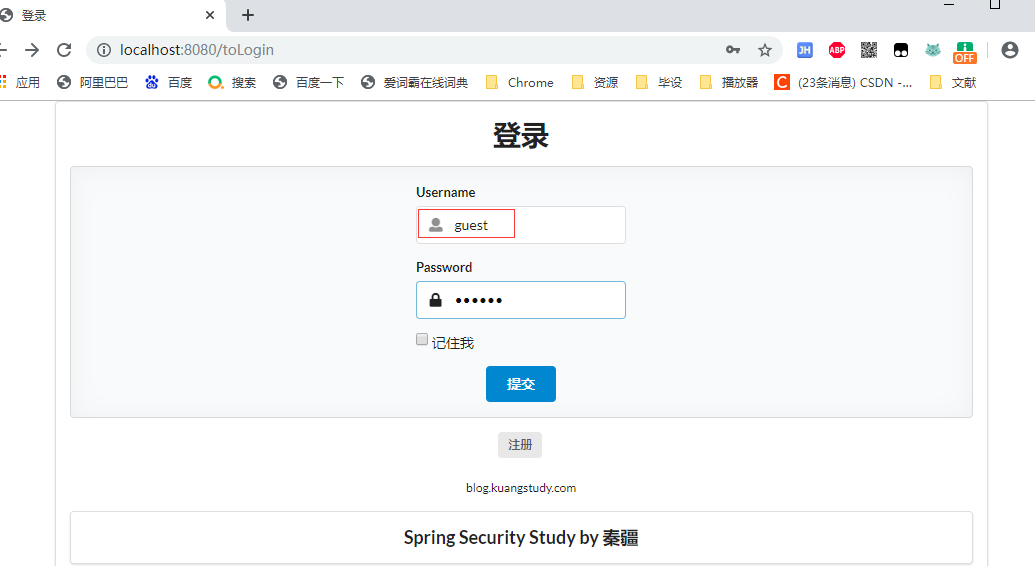
登錄成功:
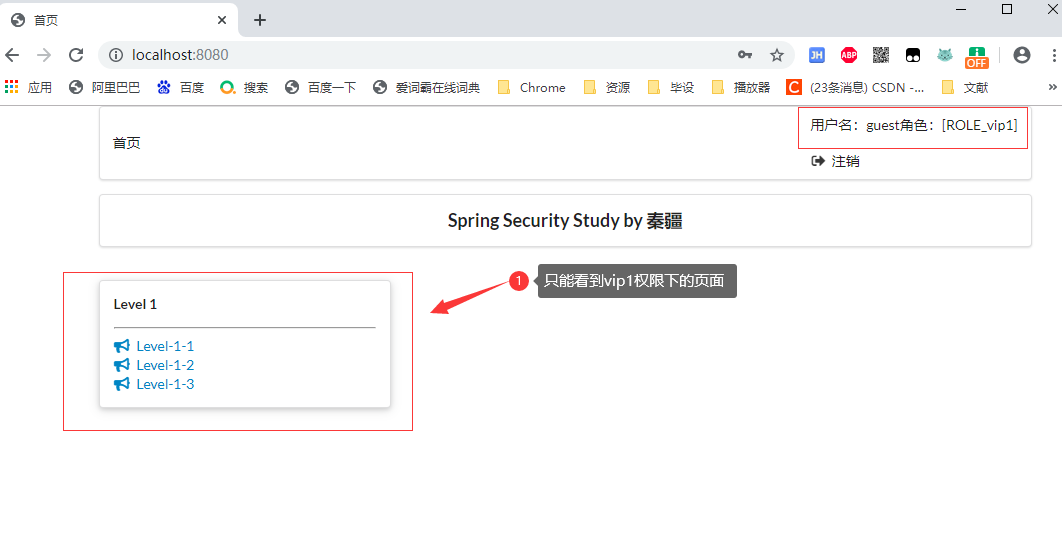
2.6.1.2 只有 vip1, vip2 許可權
登錄:kuangshen 用戶
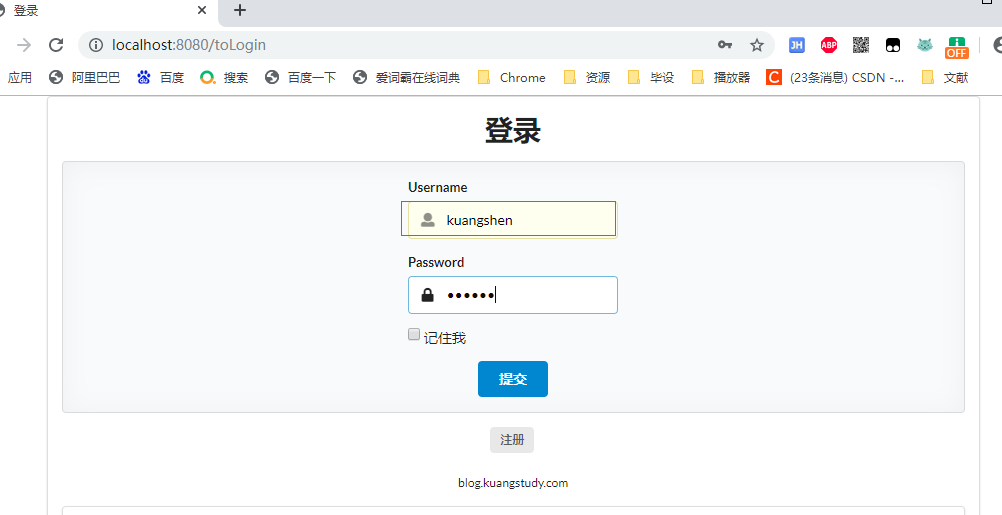
登陸成功:
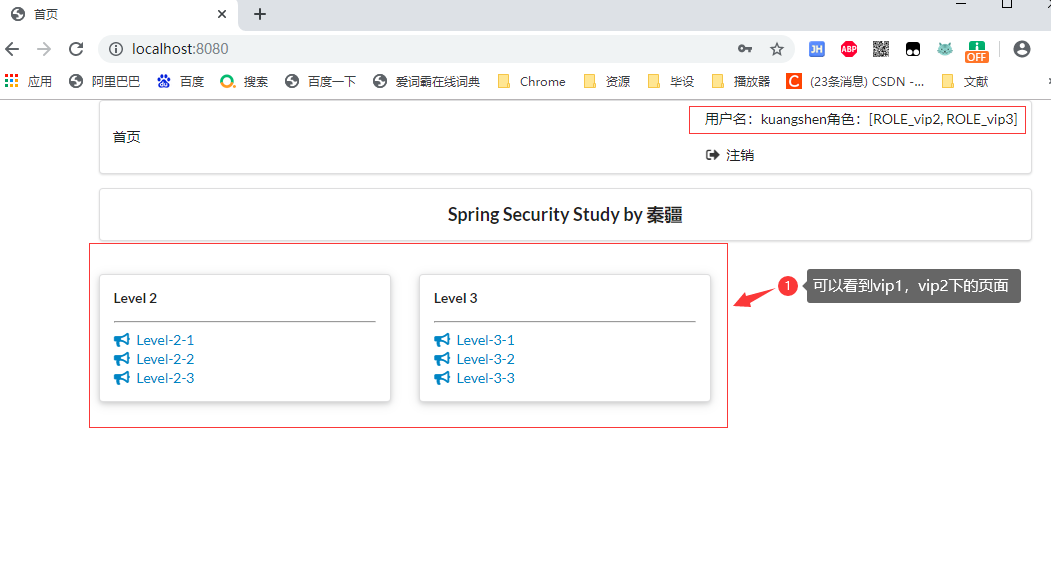
2.6.1.3 只有 vip1, vip2, vip3 許可權
登錄:root 用戶
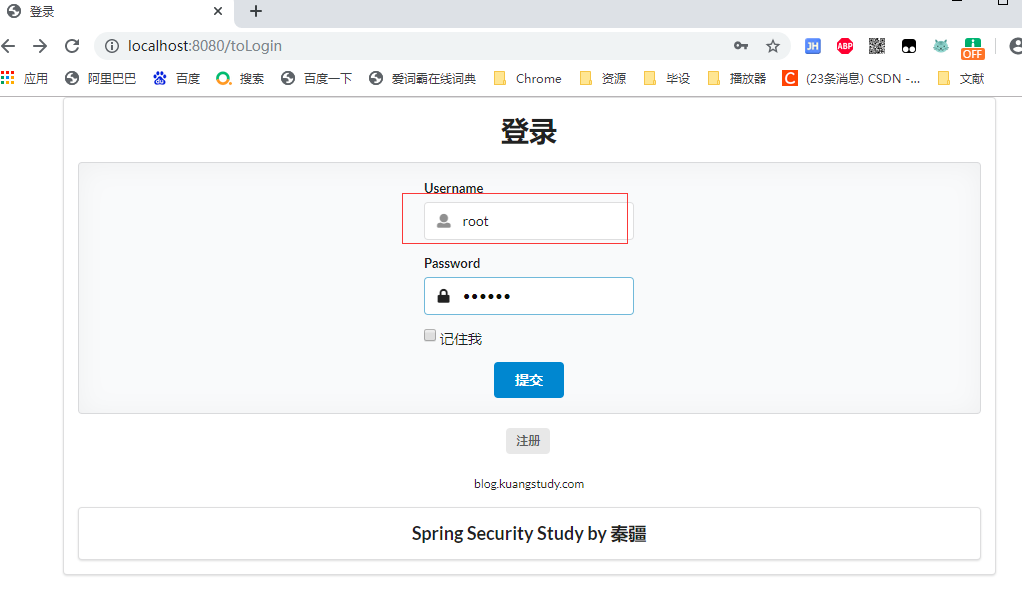
登陸成功
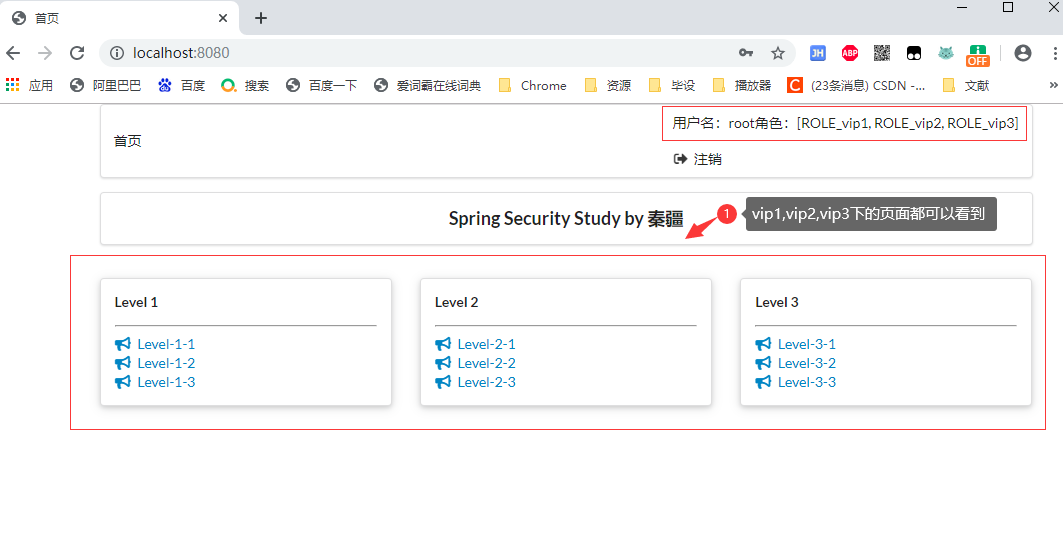
2.6.2 記住我
2.6.2.1 登錄
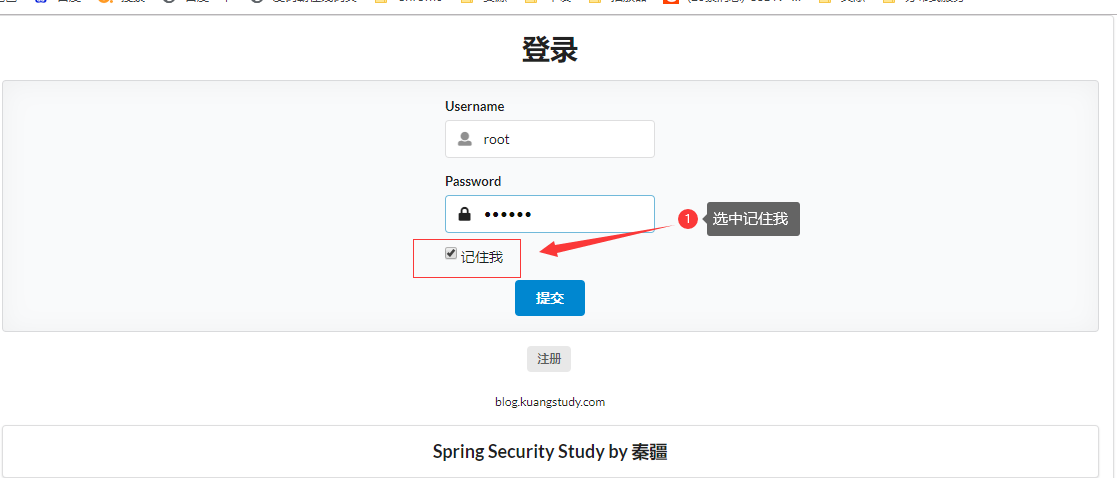
2.6.2.2 登錄成功
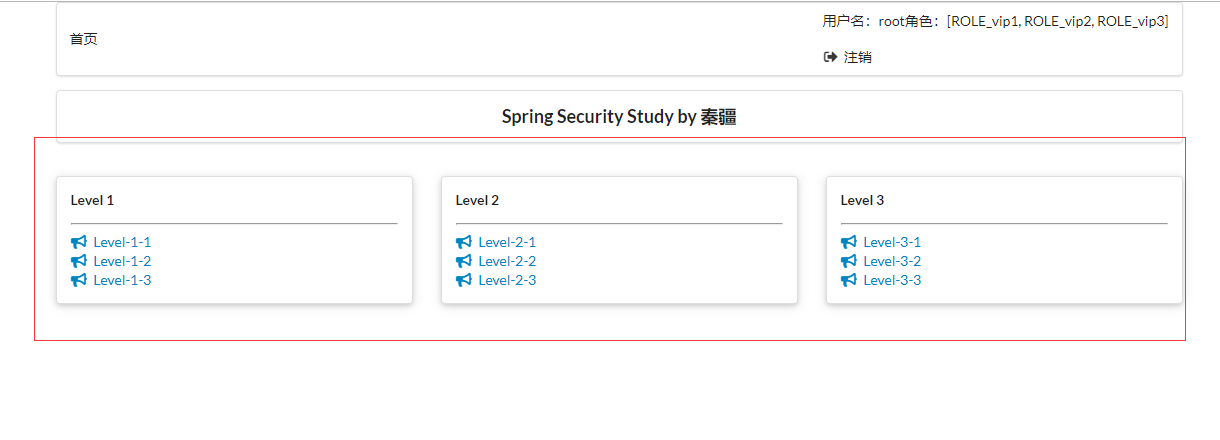
2.6.2.3 關閉瀏覽器,重新訪問 http://localhost:8080/
登錄成功
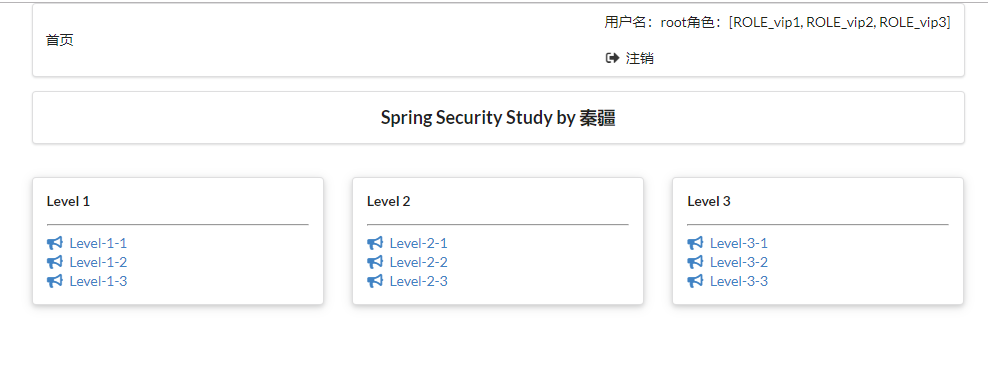
檢查Cookie
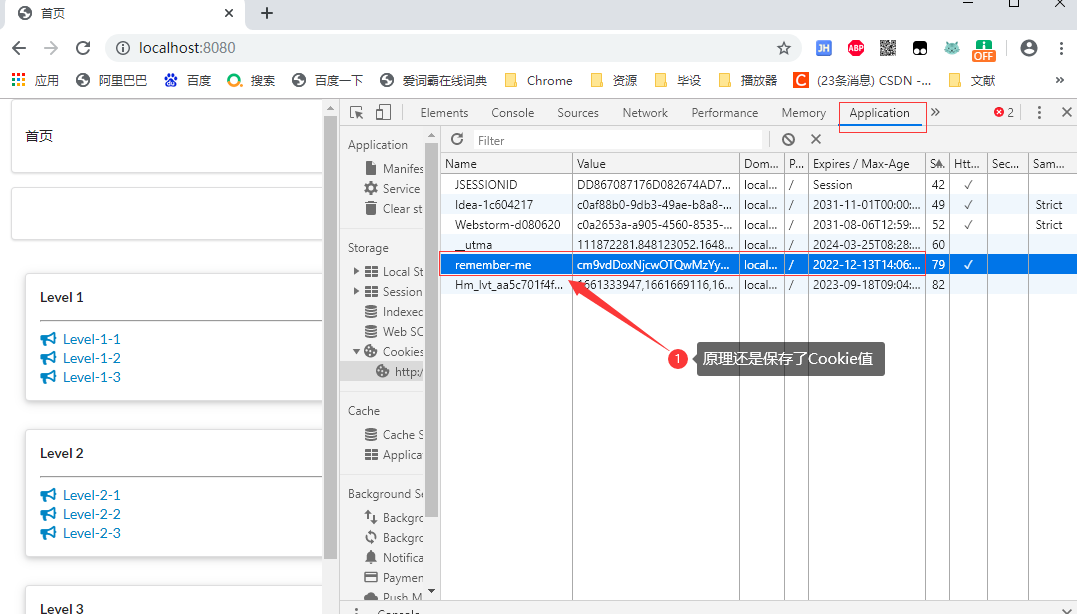
參考博客地址:https://mp.weixin.qq.com/s/FLdC-24_pP8l5D-i7kEwcg
視頻地址:https://www.bilibili.com/video/BV1PE411i7CV/?p=34
3、Shiro
3.1 helloShiro快速開始
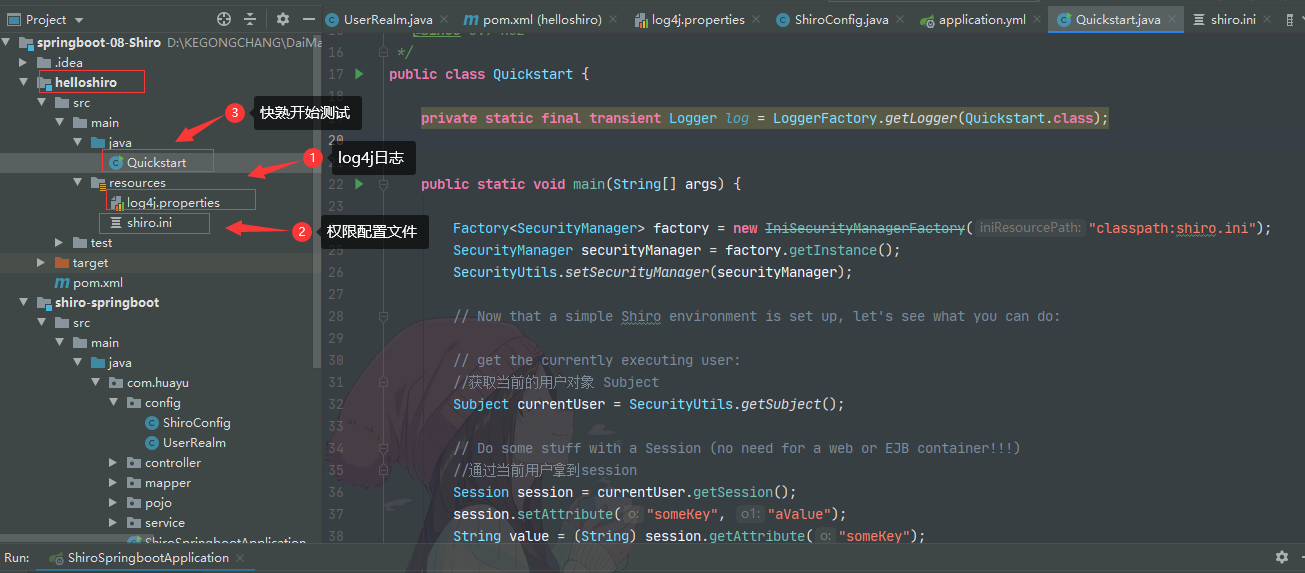
3.1.1 依賴
<!-- shiro-core -->
<dependency>
<groupId>org.apache.shiro</groupId>
<artifactId>shiro-core</artifactId>
<version>1.7.1</version>
</dependency>
<!-- configure logging -->
<dependency>
<groupId>org.slf4j</groupId>
<artifactId>jcl-over-slf4j</artifactId>
<version>1.7.21</version>
</dependency>
<dependency>
<groupId>org.slf4j</groupId>
<artifactId>slf4j-log4j12</artifactId>
<version>1.7.21</version>
</dependency>
<dependency>
<groupId>log4j</groupId>
<artifactId>log4j</artifactId>
<version>1.2.17</version>
</dependency>
3.1.2 log4j.properties
log4j.rootLogger=INFO, stdout
log4j.appender.stdout=org.apache.log4j.ConsoleAppender
log4j.appender.stdout.layout=org.apache.log4j.PatternLayout
log4j.appender.stdout.layout.ConversionPattern=%d %p [%c] - %m %n
# General Apache libraries
log4j.logger.org.apache=WARN
# Spring
log4j.logger.org.springframework=WARN
# Default Shiro logging
log4j.logger.org.apache.shiro=INFO
# Disable verbose logging
log4j.logger.org.apache.shiro.util.ThreadContext=WARN
log4j.logger.org.apache.shiro.cache.ehcache.EhCache=WARN
3.1.3 shiro.ini
[users]
# user 'root' with password 'secret' and the 'admin' role
root = secret, admin
# user 'guest' with the password 'guest' and the 'guest' role
guest = guest, guest
# user 'presidentskroob' with password '12345' ("That's the same combination on
# my luggage!!!" ;)), and role 'president'
presidentskroob = 12345, president
# user 'darkhelmet' with password 'ludicrousspeed' and roles 'darklord' and 'schwartz'
darkhelmet = ludicrousspeed, darklord, schwartz
# user 'lonestarr' with password 'vespa' and roles 'goodguy' and 'schwartz'
lonestarr = vespa, goodguy, schwartz
# -----------------------------------------------------------------------------
# Roles with assigned permissions
#
# Each line conforms to the format defined in the
# org.apache.shiro.realm.text.TextConfigurationRealm#setRoleDefinitions JavaDoc
# -----------------------------------------------------------------------------
[roles]
# 'admin' role has all permissions, indicated by the wildcard '*'
admin = *
# The 'schwartz' role can do anything (*) with any lightsaber:
schwartz = lightsaber:*
# The 'goodguy' role is allowed to 'drive' (action) the winnebago (type) with
# license plate 'eagle5' (instance specific id)
goodguy = winnebago:drive:eagle5
3.1.4 Quickstart
/**
* Simple Quickstart application showing how to use Shiro's API.
*
* @since 0.9 RC2
*/
public class Quickstart {
private static final transient Logger log = LoggerFactory.getLogger(Quickstart.class);
public static void main(String[] args) {
Factory<SecurityManager> factory = new IniSecurityManagerFactory("classpath:shiro.ini");
SecurityManager securityManager = factory.getInstance();
SecurityUtils.setSecurityManager(securityManager);
// Now that a simple Shiro environment is set up, let's see what you can do:
// get the currently executing user:
//獲取當前的用戶對象 Subject
Subject currentUser = SecurityUtils.getSubject();
// Do some stuff with a Session (no need for a web or EJB container!!!)
//通過當前用戶拿到session
Session session = currentUser.getSession();
session.setAttribute("someKey", "aValue");
String value = (String) session.getAttribute("someKey");
if (value.equals("aValue")) {
log.info("Retrieved the correct value! [" + value + "]");
}
//判斷當前用戶是否被認證
//Token:沒有獲取,直接設置令牌
if (!currentUser.isAuthenticated()) {
UsernamePasswordToken token = new UsernamePasswordToken("lonestarr", "vespa");
token.setRememberMe(true);//設置記住我
try {
currentUser.login(token);//執行登錄操作
} catch (UnknownAccountException uae) {
log.info("There is no user with username of " + token.getPrincipal());
} catch (IncorrectCredentialsException ice) {
log.info("Password for account " + token.getPrincipal() + " was incorrect!");
} catch (LockedAccountException lae) {
log.info("The account for username " + token.getPrincipal() + " is locked. " +
"Please contact your administrator to unlock it.");
}
// ... catch more exceptions here (maybe custom ones specific to your application?
catch (AuthenticationException ae) {
//unexpected condition? error?
}
}
//say who they are:
//print their identifying principal (in this case, a username):
log.info("User [" + currentUser.getPrincipal() + "] logged in successfully.");
//test a role:
if (currentUser.hasRole("schwartz")) {
log.info("May the Schwartz be with you!");
} else {
log.info("Hello, mere mortal.");
}
//粗粒度
//test a typed permission (not instance-level)
if (currentUser.isPermitted("lightsaber:wield")) {
log.info("You may use a lightsaber ring. Use it wisely.");
} else {
log.info("Sorry, lightsaber rings are for schwartz masters only.");
}
//細粒度
//a (very powerful) Instance Level permission:
if (currentUser.isPermitted("winnebago:drive:eagle5")) {
log.info("You are permitted to 'drive' the winnebago with license plate (id) 'eagle5'. " +
"Here are the keys - have fun!");
} else {
log.info("Sorry, you aren't allowed to drive the 'eagle5' winnebago!");
}
//註銷
//all done - log out!
currentUser.logout();
//結束
System.exit(0);
}
}

3.1.5 測試

3.2 整合SpringBoot,MyBatis,Thymeleaf
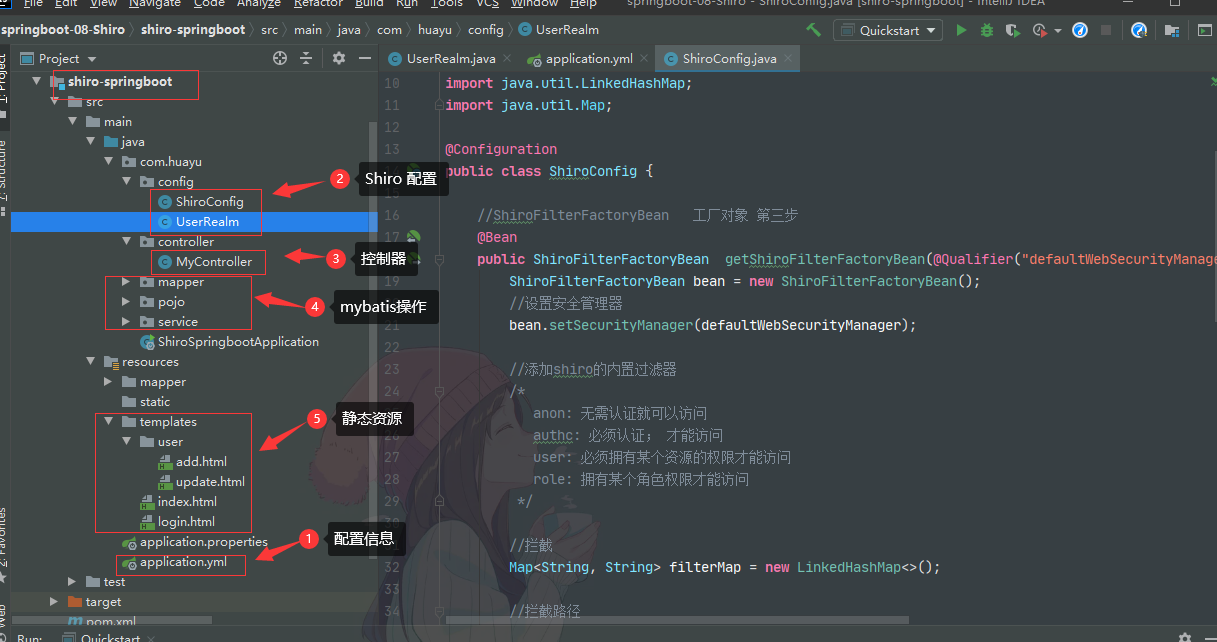
3.2.1 依賴
<!--
Subject 用戶
SecurityManger 管理所有用戶和
Realm 連接資料庫
-->
<!--shiro整合包-->
<dependency>
<groupId>org.apache.shiro</groupId>
<artifactId>shiro-spring</artifactId>
<version>1.7.1</version>
</dependency>
<!-- thymeleaf模板 -->
<dependency>
<groupId>org.thymeleaf</groupId>
<artifactId>thymeleaf-spring5</artifactId>
</dependency>
<dependency>
<groupId>org.thymeleaf.extras</groupId>
<artifactId>thymeleaf-extras-java8time</artifactId>
</dependency>
<!-- log4j -->
<dependency>
<groupId>org.slf4j</groupId>
<artifactId>slf4j-log4j12</artifactId>
<version>1.7.21</version>
</dependency>
<dependency>
<groupId>log4j</groupId>
<artifactId>log4j</artifactId>
<version>1.2.17</version>
</dependency>
<!-- druid -->
<dependency>
<groupId>com.alibaba</groupId>
<artifactId>druid</artifactId>
<version>1.1.21</version>
</dependency>
<!-- mysql-connector-java -->
<dependency>
<groupId>mysql</groupId>
<artifactId>mysql-connector-java</artifactId>
<scope>runtime</scope>
</dependency>
<!-- spring-boot-starter-jdbc -->
<dependency>
<groupId>org.springframework.boot</groupId>
<artifactId>spring-boot-starter-jdbc</artifactId>
</dependency>
<!-- mybatis-spring-boot-starter -->
<dependency>
<groupId>org.mybatis.spring.boot</groupId>
<artifactId>mybatis-spring-boot-starter</artifactId>
<version>2.1.4</version>
</dependency>
<dependency>
<groupId>org.projectlombok</groupId>
<artifactId>lombok</artifactId>
<version>1.18.22</version>
</dependency>
<!-- shiro-thymeleaf 整合-->
<!--導入thymeleaf依賴-->
<dependency>
<groupId>org.thymeleaf</groupId>
<artifactId>thymeleaf-spring5</artifactId>
<version>3.0.11.RELEASE</version>
</dependency>
<dependency>
<groupId>org.thymeleaf.extras</groupId>
<artifactId>thymeleaf-extras-java8time</artifactId>
<version>3.0.4.RELEASE</version>
</dependency>
<!--shiro-thymeleaf整合-->
<dependency>
<groupId>com.github.theborakompanioni</groupId>
<artifactId>thymeleaf-extras-shiro</artifactId>
<version>2.0.0</version>
</dependency>
3.2.2 application.yml
spring:
datasource:
username: root
password: 17585273765
url: jdbc:mysql://localhost:3306/mybatis?serverTimezone=GMT&useUnicode=true&characterEncoding=utf-8
driver-class-name: com.mysql.cj.jdbc.Driver
type: com.alibaba.druid.pool.DruidDataSource
#Spring Boot 預設是不註入這些屬性值的,需要自己綁定
#druid 數據源專有配置
initialSize: 5
minIdle: 5
maxActive: 20
maxWait: 60000
timeBetweenEvictionRunsMillis: 60000
minEvictableIdleTimeMillis: 300000
validationQuery: SELECT 1 FROM DUAL
testWhileIdle: true
testOnBorrow: false
testOnReturn: false
poolPreparedStatements: true
#配置監控統計攔截的filters,stat:監控統計、log4j:日誌記錄、wall:防禦sql註入
#如果允許時報錯 java.lang.ClassNotFoundException: org.apache.log4j.Priority
#則導入 log4j 依賴即可,Maven 地址:https://mvnrepository.com/artifact/log4j/log4j
filters: stat,wall,log4j
maxPoolPreparedStatementPerConnectionSize: 20
useGlobalDataSourceStat: true
connectionProperties: druid.stat.mergeSql=true;druid.stat.slowSqlMillis=500
thymeleaf:
cache: false
3.2.3 靜態資源
3.2.3.1 login.html
<!DOCTYPE html>
<html lang="en" xmlns:th="http://www.themeleaf.org">
<head>
<meta charset="UTF-8">
<title>登錄頁面</title>
</head>
<body>
<h1>登錄</h1>
<p th:text="${msg}" style="color: red"></p>
<form th:action="@{/login}">
<p>用戶名: <input type="text" name="username"></p>
<p>密碼: <input type="text" name="password"></p>
<p><input type="submit"></p>
</form>
</body>
</html>
3.2.3.2 index.html
<!DOCTYPE html>
<html lang="en" xmlns:th="http://www.themeleaf.org"
xmlns:shiro="http://www.thymeleaf.org/thymeleaf-extras-shiro" >
<head>
<meta charset="UTF-8">
<title>首頁</title>
</head>
<body>
<h1>首頁</h1>
<p th:if="${session.loginUser} == null" >
<a th:href="@{/toLogin}">登錄</a>
</p>
<p th:text="${msg}"></p>
<hr>
<div shiro:hasPermission="user:add">
<a th:href="@{/user/add}">add</a>
</div>
<div shiro:hasPermission="user:update">
<a th:href="@{/user/update}">update</a>
</div>
</body>
</html>
3.2.3.3 add.html
<!DOCTYPE html>
<html lang="en">
<head>
<meta charset="UTF-8">
<title>添加頁面</title>
</head>
<body>
<h1>add</h1>
</body>
</html>
3.2.3.4 update.html
<!DOCTYPE html>
<html lang="en">
<head>
<meta charset="UTF-8">
<title>修改頁面</title>
</head>
<body>
<h1>update</h1>
</body>
</html>
3.2.4 根據用戶名和密碼查詢用戶信息

3.2.5 shiro配置信息
3.2.5.1 UserRealm 認證
//自定義的 UserRealm extends AuthorizingRealm
public class UserRealm extends AuthorizingRealm {
@Autowired
UserService userService;
//授權
@Override
protected AuthorizationInfo doGetAuthorizationInfo(PrincipalCollection principalCollection) {
System.out.println("執行了=>授權doGetAuthorizationInfo");
SimpleAuthorizationInfo info = new SimpleAuthorizationInfo();
//info.addStringPermission("user:add"); //給用戶添加add許可權
//拿到當前登錄的這個對象
Subject subject = SecurityUtils.getSubject();
User currentUser = (User)subject.getPrincipal(); //Shiro取出當前對象 拿到user對象
//設置當前用戶的許可權
info.addStringPermission(currentUser.getPerms());
return info;
}
//認證
@Override
protected AuthenticationInfo doGetAuthenticationInfo(AuthenticationToken token) throws AuthenticationException {
System.out.println("執行了=>認證doGetAuthenticationInfo");
//用戶名 密碼 模擬 資料庫中取
// String name = "root";
// String password = "123456";
UsernamePasswordToken userToken = (UsernamePasswordToken)token;
//連接真實資料庫
User user = userService.queryUserByName(userToken.getUsername());
//模擬判斷
/* if (!userToken.getUsername().equals(name)){
return null; //拋出異常 UnknownAccountException
}
//密碼認證 shiro
return new SimpleAuthenticationInfo("",user.password,"");
*/
//資料庫判斷
if(user == null){ //沒有這個人
return null;
}
//獲取session對象,保存user對象
Subject currentSubject = SecurityUtils.getSubject();
Session session = currentSubject.getSession();
session.setAttribute("loginUser",user);
//可以加密:md5 md5鹽值加密
//密碼認證 shiro
//第一個參數user是為了傳遞參數
return new SimpleAuthenticationInfo(user,user.getPwd(),"");
}
}
3.2.5.2 ShiroConfig 授權
@Configuration
public class ShiroConfig {
//ShiroFilterFactoryBean 工廠對象 第三步
@Bean
public ShiroFilterFactoryBean getShiroFilterFactoryBean(@Qualifier("defaultWebSecurityManager") DefaultWebSecurityManager defaultWebSecurityManager){
ShiroFilterFactoryBean bean = new ShiroFilterFactoryBean();
//設置安全管理器
bean.setSecurityManager(defaultWebSecurityManager);
//添加shiro的內置過濾器
/*
anon: 無需認證就可以訪問
authc: 必須認證; 才能訪問
user: 必須擁有某個資源的許可權才能訪問
role: 擁有某個角色許可權才能訪問
*/
//攔截
Map<String, String> filterMap = new LinkedHashMap<>();
//攔截路徑
// filterMap.put("/user/add","authc");
// filterMap.put("/user/update","authc");
//授權 ,正常情況下,沒有授權會跳到未授權頁面
filterMap.put("/user/add","perms[user:add]"); //有add許可權的user才可以訪問/user/add
filterMap.put("/user/update","perms[user:update]");
bean.setFilterChainDefinitionMap(filterMap);
bean.setLoginUrl("/toLogin"); //設置登錄的請求
//未授權頁面
bean.setUnauthorizedUrl("/noauth");
return bean;
}
//DefaultWebSecurityManger 安全對象 第二步
@Bean("defaultWebSecurityManager")
public DefaultWebSecurityManager getDefaultWebSecurityManager(@Qualifier("userRealm") UserRealm userRealm){
DefaultWebSecurityManager securityManager = new DefaultWebSecurityManager();
//關聯 userRealm
securityManager.setRealm(userRealm);
return securityManager;
}
//創建 realm 對象 ,需要自定義類 第一步
@Bean(name = "userRealm")
public UserRealm userRealm(){
return new UserRealm();
}
//整合ShiroDialect:用來整合 Shiro
@Bean
public ShiroDialect getShiroDialect(){
return new ShiroDialect();
}
}
3.2.6 控制層
@Controller
public class MyController {
//index
@GetMapping({"/","/index"})
public String toIndex(Model model){
model.addAttribute("msg","hello,shiro");
return "index";
}
//add
@RequestMapping("/user/add")
public String add(){
return "user/add";
}
//update
@RequestMapping("/user/update")
public String update(){
return "user/update";
}
//去登錄
@RequestMapping("/toLogin")
public String toLogin(){
return "login";
}
//登錄
@RequestMapping("/login")
public String login( String username, String password,Model model){
//獲取當前的用戶
Subject subject = SecurityUtils.getSubject();
//封裝用戶的登陸數據
UsernamePasswordToken token = new UsernamePasswordToken(username, password);
try {
subject.login(token); //執行登陸方法,如果沒有異常就說明Ok
return "index"; //登錄成功,返迴首頁
}catch (UnknownAccountException e){ //用戶名bu存在
model.addAttribute("msg","用戶名錯誤");
return "login";
}catch (IncorrectCredentialsException e){ //密碼不存在
model.addAttribute("msg","密碼錯誤");
return "login";
}
}
//未授權
@RequestMapping("/noauth")
@ResponseBody
public String unauthorized(){
return "未經授權無法訪問此頁面!!!";
}
}
3.2.7 測試
3.2.7.1 沒有許可權
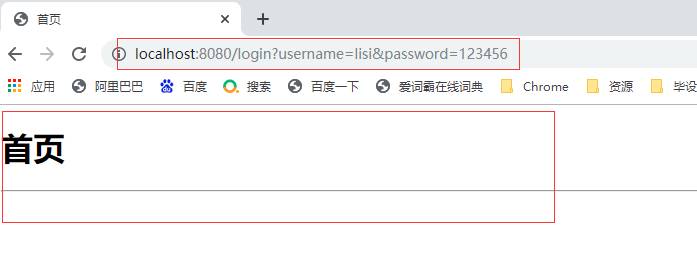
3.2.7.2 add 許可權

3.2.7.3 update 許可權

3.2.7.4 add + update 許可權
